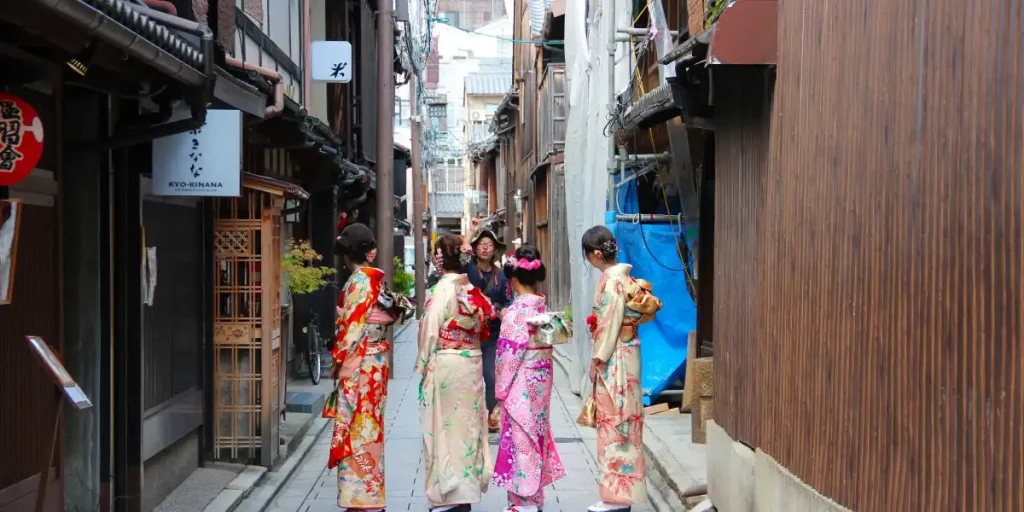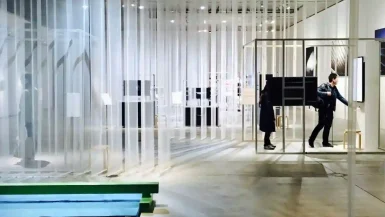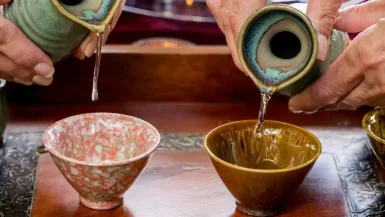Introduction
The kimono, a timeless symbol of Japanese culture, embodies elegance and tradition. This traditional Japanese attire, with its rich history and intricate designs, continues to captivate the world. In this detailed blog, we will explore the history, types, craftsmanship, and cultural significance of the kimono. Join us on a journey to understand the beauty and importance of this iconic garment.
The History of Kimono: Traditional Japanese Attire
Origins and Early Development
The origins of the Traditional Japanese Attire can be traced back to the Heian period (794-1185). During this time, Japanese aristocracy favored elaborate robes known as “junihitoe.” These early garments, made of multiple layers, showcased intricate designs and vibrant colors.
In the subsequent Kamakura period (1185-1333), the style of clothing evolved. The “kosode,” a precursor to the modern kimono, became popular. This simpler, single-layer garment was worn by both men and women. Over time, the kosode developed into the kimono we recognize today.
Edo Period: The Golden Age
The Edo period (1603-1868) marked a golden age for kimono. This era saw the rise of the merchant class, who displayed their wealth through elaborate kimonos. The garment became a canvas for artistic expression, featuring intricate embroidery, dyeing techniques, and luxurious fabrics.
During this period, the “obi,” a wide sash used to secure the kimono, gained prominence. The obi evolved into a decorative element, often more elaborate than the kimono itself. This era also saw the development of various kimono styles and patterns, each with specific meanings and occasions.
Modern Era: Preservation and Innovation
In the Meiji period (1868-1912), Japan opened up to Western influences. Western clothing became more common, especially for men. However, the Traditional Japanese Attire remained a significant part of Japanese culture. It adapted to modern times while preserving traditional elements.
Today, kimonos are worn on special occasions such as weddings, tea ceremonies, and festivals. The traditional Japanese attire continues to evolve, blending contemporary designs with classical techniques.
Types of Kimono: Traditional Japanese Attire
Furisode: The Formal Kimono for Young Women
Furisode, characterized by its long, flowing sleeves, is the most formal attire worn by young unmarried women. It is often seen at coming-of-age ceremonies and weddings. The vibrant colors and elaborate patterns make it a standout piece of traditional Japanese attire.
Tomesode: The Married Woman’s Kimono
Tomesode is the formal kimono worn by married women. It features shorter sleeves compared to furisode and usually comes in more subdued colors. The patterns on tomesode are generally placed below the waist, symbolizing a woman’s maturity and status.
Yukata: The Casual Summer Kimono
Yukata, a casual and lightweight kimono, is typically worn during summer festivals and at hot springs. Made from cotton, it is easy to wear and care for. The simple design and vibrant colors make it a popular choice for both men and women.
Houmongi: The Semi-Formal Kimono
Houmongi is a versatile kimono worn by both married and unmarried women. It is suitable for semi-formal occasions such as tea ceremonies and parties. The patterns on houmongi are continuous across the seams, showcasing the skill of the craftsman.
Uchikake: The Bridal Kimono
Uchikake is a lavishly decorated kimono worn by brides during traditional Japanese weddings. It is often heavily embroidered with gold and silver threads, featuring auspicious motifs like cranes and flowers. This formal garment is worn over a furisode and remains open in the front.
Montsuki: The Formal Kimono for Men
Montsuki is the most formal kimono worn by men, typically at weddings and funerals. It features the family crest (“mon”) on the chest, shoulders, and back. Montsuki is usually worn with “hakama” (pleated trousers) and “haori” (a formal coat).
Craftsmanship Behind Traditional Japanese Attire
Fabric Selection
The fabric used for Traditional Japanese Attire plays a crucial role in their beauty and durability. Traditionally, kimonos are made from silk, known for its luxurious feel and sheen. However, cotton, wool, and synthetic fabrics are also used for casual and seasonal kimonos.
Dyeing Techniques
The dyeing process is an essential aspect of kimono craftsmanship. “Yuzen” is a popular technique involving hand-painting intricate designs on the fabric. Another method, “shibori,” creates patterns by binding and dyeing the cloth. These techniques require great skill and precision.
Weaving Methods
Weaving techniques add texture and depth to kimonos. “Nishijin-ori,” a traditional weaving method from Kyoto, produces stunning brocade fabrics. This labor-intensive process involves weaving gold and silver threads into intricate patterns, creating luxurious and ornate textiles.
Embroidery
Embroidery enhances the beauty of Traditional Japanese Attires with delicate and detailed designs. “Nuihaku” is a traditional embroidery technique that uses silk and metallic threads. This method adds richness and elegance to the kimono, making it a true work of art.
Tailoring
The final step in creating a kimono is tailoring. The fabric is carefully cut and sewn together, ensuring precise alignment of patterns. Traditional Japanese attire requires skilled craftsmanship to achieve a perfect fit and seamless appearance.

Cultural Significance Traditional Japanese Attire
Symbolism and Meaning
This Traditional Japanese Attires are rich in symbolism, with each element carrying specific meanings. Colors, patterns, and motifs are chosen based on the occasion, season, and the wearer’s status. For example, cranes represent longevity and good fortune, while cherry blossoms symbolize the transient nature of life.
The Traditional Japanese Attire in Ceremonies
The attire play a significant role in Japanese ceremonies and rituals. At weddings, brides wear elaborate kimonos, symbolizing purity and elegance. During the coming-of-age ceremony, young women don furisode, marking their transition to adulthood. These traditional Japanese attires add depth and meaning to important life events.
Festivals and Celebrations
Festivals are vibrant occasions where Traditional Japanese Attires are prominently displayed. During “Hanami” (cherry blossom viewing) and “Matsuri” (festivals), people wear colorful yukatas and kimonos, celebrating their cultural heritage. These events provide an opportunity to showcase the beauty and diversity of traditional Japanese attire.
The Role of Traditional Japanese Attire in Modern Japan
Despite the influence of Western clothing, attires remain a cherished part of Japanese culture. Many people wear kimonos on special occasions, preserving their cultural identity. The fashion industry has also embraced kimono-inspired designs, blending traditional elements with modern aesthetics.
Wearing a Kimono: Traditional Japanese Attire
The Components of a Kimono
A complete kimono ensemble consists of several components:
- Kimono: The main garment, typically made of silk or cotton.
- Obi: A wide sash tied around the waist, often intricately decorated.
- Nagajuban: An undergarment worn beneath the kimono.
- Tabi: Split-toe socks worn with traditional sandals.
- Geta or Zori: Traditional wooden or straw sandals.
How to Wear a Kimono
Wearing a kimono requires careful attention to detail. Here are the basic steps:
- Wear the Nagajuban: Put on the undergarment, ensuring it fits snugly.
- Wrap the attire: Drape the kimono over your shoulders, aligning the seams. Wrap the left side over the right and secure it with a sash.
- Tie the Obi: Wrap the obi around your waist and tie it in a decorative knot at the back.
- Adjust the attire: Ensure the kimono fits properly, with no wrinkles or gaps. Adjust the collar and sleeves as needed.
- Wear Tabi and Sandals: Put on the split-toe socks and traditional sandals to complete the ensemble.
Tips for Wearing a Kimono
- Practice Makes Perfect: Wearing an attire can be challenging, especially for beginners. Practice the steps and seek guidance from experienced wearers.
- Pay Attention to Details: Ensure the kimono is properly aligned, with the left side over the right. Avoid wrinkling the fabric and adjust the obi for a neat appearance.
- Choose Appropriate Accessories: Select accessories that complement your kimono, such as hairpins, fans, and bags. These details enhance the overall look and feel of traditional Japanese attire.
The Evolution of the Traditional Japanese Attire
Contemporary Kimono Designs
In recent years, designers have reimagined the Traditional Japanese Attire, blending traditional elements with modern styles. Contemporary kimonos feature innovative patterns, fabrics, and silhouettes, appealing to a broader audience. These modern interpretations keep the tradition alive while embracing change.
Traditional Japanese Attire in Fashion and Art
The influence of this japanese attire extends beyond traditional wear. Fashion designers and artists worldwide draw inspiration from kimono aesthetics. Runways, exhibitions, and installations showcase the timeless beauty of kimono, highlighting its impact on global fashion and art.
The Future of Traditional Japanese Attire
The future of Traditional Japanese Attire lies in its ability to adapt and evolve. Efforts to preserve traditional craftsmanship, combined with modern innovations, ensure the longevity of this cultural treasure. As interest in kimono continues to grow, both in Japan and internationally, the legacy of traditional Japanese attire will endure.
Conclusion
The kimono, a symbol of Japan’s rich cultural heritage, continues to captivate and inspire. From its historical origins to its modern interpretations, this traditional Japanese attire embodies elegance, craftsmanship, and tradition.



